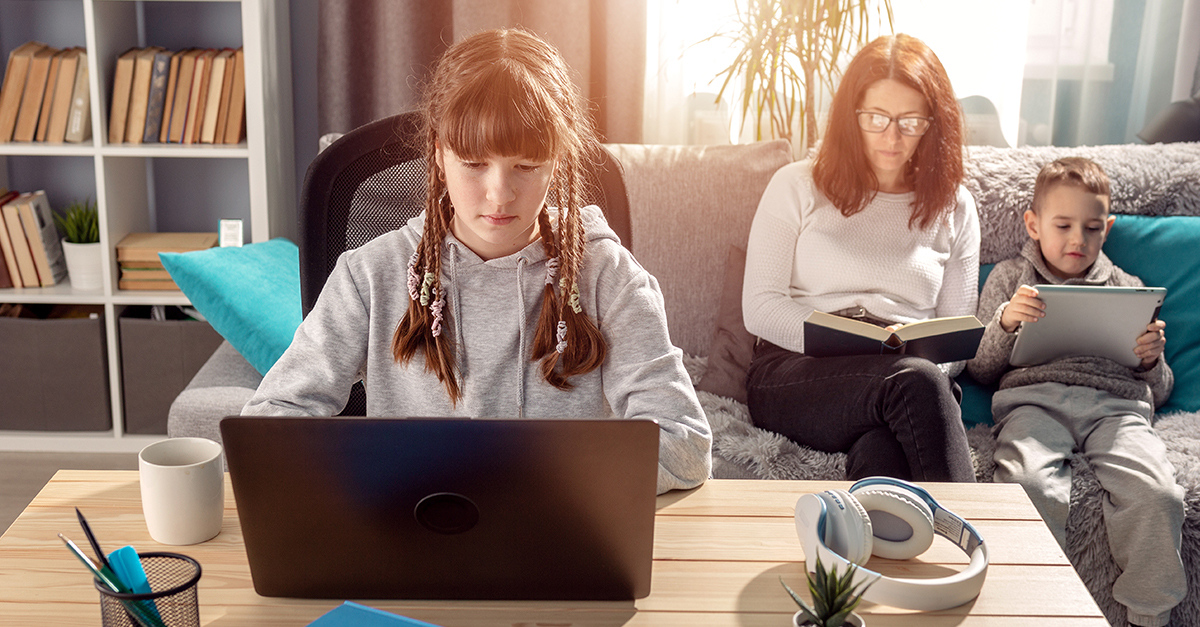3 Ways to Balance Technology in Your Family

How does a family stay safe and sane in the face of so many screens vying for our attention? Finding a balance with technology is key.
Many of us use computers in order to complete our jobs and even as a medium for education. While the inherent value of media is almost a necessity for many families, how do we balance the necessary and entertainment sides of media to have a healthy lifestyle? My children, ages 3 and 7, want to use the iPad and watch TV, so I’ve learned how to have age-appropriate conversations with them. Here are tips for parents and children:
3 Ways to Balance Technology in Your Family
1) Set Guidelines
Sometimes, setting time limits can have gray areas because the use of a screen is necessary to complete schoolwork or other tasks. But being aware of the time spent on the screen will help lead a discussion about how much time your family spends on the screen versus other activities. Discuss general guidelines and start to track how much time family members spend on media of any kind. Everyone might be surprised at the results! Have a family discussion about how your family values its time, and how replacing 1 hour of screen time with another activity could be beneficial. Tie this discussion into larger goals and values your family sets.
The key is that your family’s time is balanced by doing a variety of activities. Experts recommend 1-2 hours of screen time a day for children and teens (Source). Keep this in mind as you create your guidelines. In addition, be sure that the time they do spend is high quality and focused on a task or educational goal.
2) See the Screen
No matter what the age of the child, be aware of how they use the screen. Set limits on where your child can use their screen as it is age appropriate. Use of the screen in open family areas is the safest and lets you know how your children are using the device. In addition, spend time right next to your child enjoying the apps they enjoy, and ask questions about what they are doing. My son often asks me, “Mommy, can we sit and cuddle and use the iPad?” What I think he is really saying is: “Will you be with me and enter my world?” I often learn about how he thinks, solves problems, what makes him laugh, and how he is successful. As a parent it is fun to try the games my children enjoy, and puts me in their shoes. Often, I am not as successful as they are, and I think that showing that I struggle to complete the game shows how we are all different and have different strengths and weaknesses.
3) Set a Good Example
If your family decides that the dinner table is not a place to use a screen, then make sure everyone follows the rule, adults and children alike. Establish a code word or fun saying to keep everyone on task so children can hold adults accountable as well. It’s okay to show the struggle adults go through in finding the elusive balance. Technology does have a strong allure and children will value your honesty about its use. Be intentional about setting aside time for family activities in which it’s clear that no one is using media of any type. A family bonfire, hikes in the woods, creating art together or attending a concert….shared experiences help your family connect and make memories.
Finally, consider a family conversation about all of the topics above. Write your own Family Media Agreement or use ideas from Common Sense Media’s examples in order to establish your family’s expectations and beliefs before you are in the moment with your kids where ending their screen time makes them unhappy and may feel unfair. My children, young though they are, understand that there are limits to the amount of time they can spend watching TV, or using the iPad. Once Hudson reached the age of five, he was able to approximately understand the concept of a half-hour versus a one-hour television show. He knew he only got so many of those a day, so he was able to start to prioritize how he wanted to spend his screen time. This led to a more mature conversation about decisions about how we spend our time and how to make appropriate choices about the use of time. My daughter Eliza who is three, basically understands that she cannot spend long periods of time in front of the TV or iPad. This is the beginning stages of awareness and having conversations about screen time. Tackling these concepts prior to the moment will make for a healthy, balanced lifestyle for everyone.
This article was originally published in Family Magazine, 2015, Issue 3.